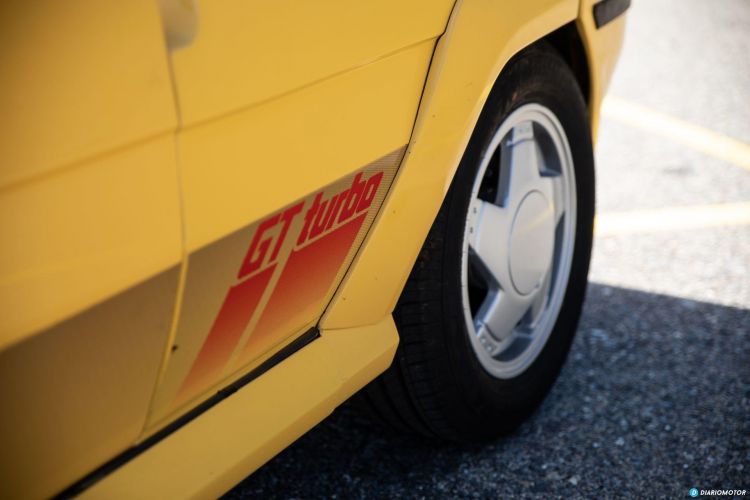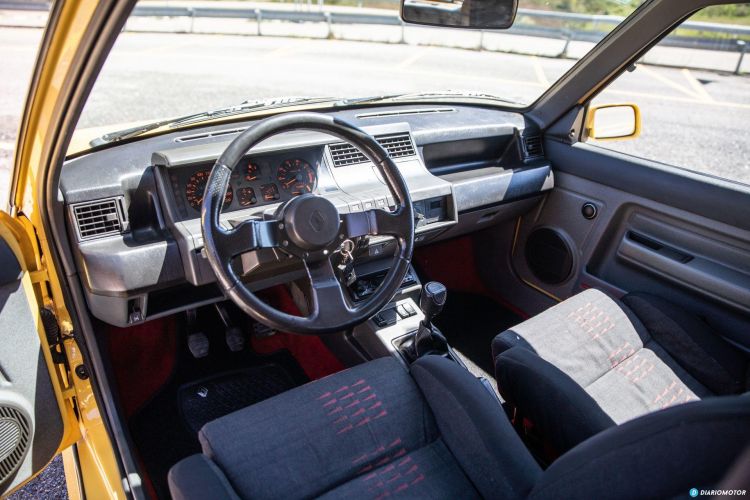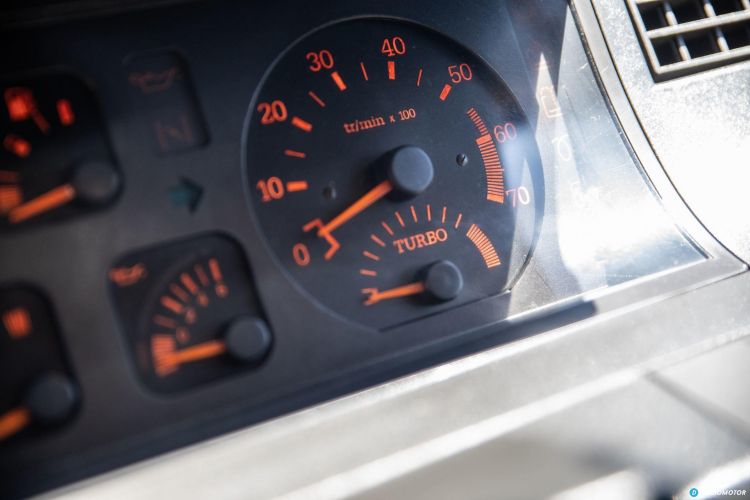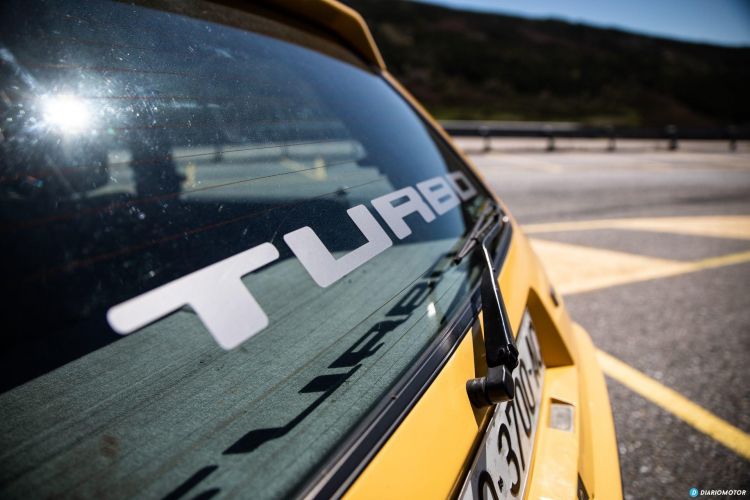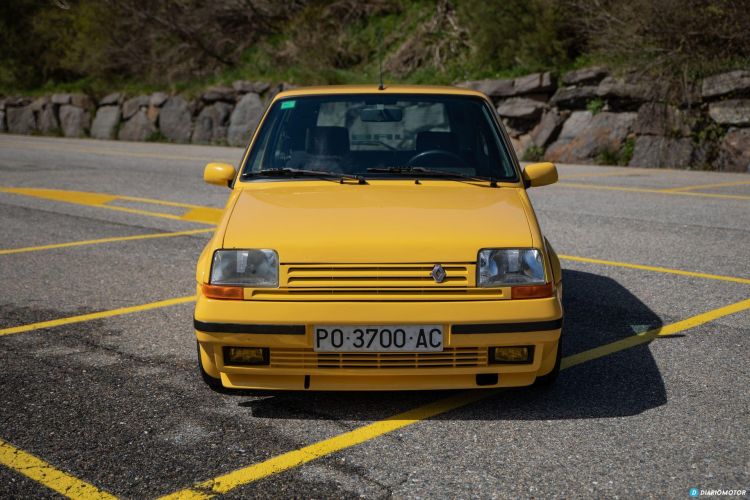Welcome to a new test of classics. Today we have with us the mythical Renault 5 GT Turbo. We are in Asturias and we are going to test this beautiful unit. We not only want to explain why the Supercinco GT Turbo was one of the greatest exponents of the GTi of the eighties, we want to tell you why every compact and sport utility has a bit of this GT Turbo in their DNA. And once and for all, we are going to dismantle the myth of “the turbos that jumped in the middle of a curve”.
Historic context
The Renault 5 GT Turbo was not the first modern sports utility. That honor goes to the Volkswagen Golf GTI, but the Supercinco GT Turbo was one of the ones that contributed the most to popularizing turbocharged mechanics in the segment, which lived its golden age in the second half of the eighties. Its precursor, the Renault 5 Copa Turbo, is considered the first sport utility with a turbocharged engine. Its crude engine and explosive power-to-weight ratio earned it a reputation as a dangerous car.
The Renault 5 GT Turbo was launched on the market in 1985.
A fame that the mid-engined Renault 5 Turbo made sure to cement with its participation in rallies in the first half of the eighties. The mythical “fat ass” has already passed through the Diariomotor channel, by the way. Together with contemporaries and rivals such as the Fiat Uno Turbo or the Peugeot 205 GTi, they inaugurated one of the most longed-for eras in the automotive world, the era of the “little GTI”affordable, powerful sports cars, and above all, a lot of fun.
Let’s analyze in detail, now, the Superfive.
Renault 5 GT Turbo design
The first thing that strikes you is how small the R5 GT Turbo is compared to any current car. A modern Renault Clio is 4.05 meters long. This R5 measures only 3.59 meters2 centimeters more than a Fiat 500. Its design, born from Marcello Gandini’s pencil, creator of cars such as the Lamborghini Countach or the “fat ass” R5 Turbo, is possibly one of the most representative and iconic cars of the eighties. Most of the GT Turbos sold were white, and the fact that it’s yellow adds an even more exotic touch to this unit, which is practically in museum condition.
We start at the front. we love the Renault asymmetric emblem, introduced in 1987 with the facelift of the Superfive, known as “Phase 2” in our country. that face lift did not alter the R5’s characteristic square headlamps, but it did introduce this bumper, painted in body color and with a more aggressive design. From its side profile it is necessary to highlight some widened wheel arches.
At the time, and also now, he felt much more muscular than a normal Super Five. It was 4 cm lower than a conventional R5, and still, it looks like a “tall” car by today’s standards. I also want to dwell on these 13-inch diameter wheels and roads with 175 mm section tires. Today we are not surprised to see small GTIs with 18-inch wheels and 235 mm in diameter, but we must bear in mind that this was really sporty footwear at the time.
Before going to the rear, take a look at this profile, so loaded with straight lines, and so loaded with personality, and with that eighties vinyl that says “GT Turbo”. Why have modern cars become so serious? Perhaps from behind the GT Turbo was more similar to other Superfives, except for the bumper and a small emblem. However, and only in Spain, all GT Turbos had this gigantic vinyl that reminded them that it was not just any R5.
Interior of the Renault 5 GT Turbo
I know you want to see if the turbo kicks out in the middle of the corner, but don’t be impatient. Sitting inside the Supercinco is traveling 35 years back in time, Both as for well and for worse. It strikes me, first of all, that despite being a small and cramped interior, the feeling of space is impressive. And it is that the design of the dashboard, and above all, the huge glazed area of the car, offer us a visibility that no modern car is able to match. We have lost a lot in this aspect with the evolution of cars…
From this interior we want to highlight, first of all, these specific seats, with a little more lateral support, but somewhat soft and with few petals sparse by current standards. The steering wheel does not have an airbag, it is covered in perforated leather, and it was specific to this version. In the instrumentation, the speedometer reached 220 km/h (do you remember how impressive this was years ago?), and a small pressure gauge indicates the turbo boost pressure. I miss, yes, a pressure gauge for the oil temperature.
There is nothing special about the rest of the dashboard, the simplicity of which is beyond doubt. catches my attention how long the gear stick is and the simplicity of all the controls. All in all, this is a car from the 1980s, and it’s not as spartan or basic as other classics that have come through the canal.
The heart of the GT Turbo
You were looking forward to it. And it is that in a car like this, the rear seats or the trunk are very secondary. The most important thing about the GT Turbo is, without a doubt, its heart. Athough it does not seems, the block design of this 1,397 cc engine dates from the Renault 4 era, and is an evolution of the engine of the Renault 5 Turbo Cup. However, there are fundamental differences in how it works, and we can consider it Renault’s first modern turbo engine.
Its engine was a rod and rocker arm, with only two valves per cylinder. Rudimentary even in the eighties.
This propellant, in Phase 2, it developed 120 hp and a torque of 165 Nm at 3,750 rpm. Mounted on a car weighing just 855 kilos, it offered impressive performance (0 to 100 in 7.8 seconds and a top speed of more than 200 km/h). Keep in mind that the most basic Renault 5 barely developed 50 CV of power. But we’ll talk about that while we drive it. In the Superfive already was mounted transversely – as in any modern car – and the air was compressed by a water-cooled turbocharger, an improvement introduced in the Phase 2 that avoided problems with hot starts, and offered greater reliability.
Unlike the Copa Turbo, a much more rudimentary car, the air was compressed before going through the carburetor, to be mixed with the fuel. It should be remembered that this is not an injection engine, and despite being a relatively Recently, the two valves per cylinder were pushed by rods and rocker arms, a technology already archaic in the eighties. The power was transmitted to the ground through a manual gearbox with five close relations. Now yes, it’s time to try it.
Behind the wheel of an icon of the eighties: will we “jump the turbo”?
First of all, let’s dismantle, once again, the myth of why the turbo “jumped” in the middle of a curve. All the myths have a small part of reality, and that is that in the Renault 5 Turbo Cup, the air was mixed with the fuel, and then it was compressed by the turbo. This, coupled with rudimentary ignition system and an off-kilter carburetorNot only did it cause tremendous lag, but the turbo was not too quick to stop blowing once we lifted our foot off the accelerator.
Why then was it said that the turbo jumped in full curve? Among other things, due to this delay in the delivery of power, which could cause some “loose foot” drivers to press the accelerator more than necessary, and especially, from my point of view, because of drivers unaccustomed to such powerful and fast cars. If we add to this the quality of the tires of the time… we can suspect why this car was nicknamed “the matapijos”.
That fame of the “jumping turbo” also had the GT Turbo, but in truth, it is a more civilized car than it seems. The delay in power delivery continues to draw attention, but once the turbo is blowing, this car becomes a little rocket. Walk a lot, and walk a lot thanks to a really low weight. At the time, a Golf GTI was not only heavier, but also less powerful.
I love the steering feel, direct and without assistance. I love the raspy sound and personality of its engine. The change has relatively long travels and a lever that looks like a van, but it is not slow or unpleasant to the touch, as well as having a mechanical feel, which perfectly matches the racing character of the car. It reminds me a bit of the feel of some 90s PSAs, and I don’t mean that as a pejorative.
But without a doubt I’ll take the agility and liveliness of the chassis. This car seems completely devoid of understeer, and the rear helps us to round the corners naturally if we release the accelerator – yes, it is advisable to anticipate with the gas to give time for the turbo to blow again with force. It can be a somewhat nervous car to the limit, but we are not going to look for that limit with this unit in collector’s condition.
Conclusions and farewell
The Renault 5 GT Turbo it was succeeded by the Renault Clio 16v, and over the next two decades, virtually all sport utility and compact cars would switch to naturally aspirated engines and multi-valve heads. However, time showed that the formula for the Renault 5 GT Turbo was the most suitable. Cars like the Ford Fiesta ST or the Hyundai i20 N show that turbo technology is the present and the future of small GTIs – at least until they all go electric.
In the meantime, we will continue to enjoy these jewels of mechanics. The GT Turbo is an exciting, fast, fun car that exudes personality. It was a tremendously popular car and was one of the cars that contributed the most to democratizing high performance, thanks to a very affordable price. And without it, it would not be possible to understand today’s sport utility vehicles and compacts.


